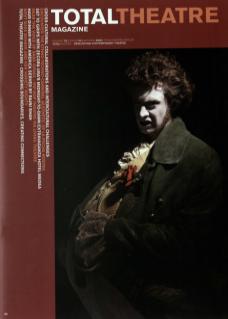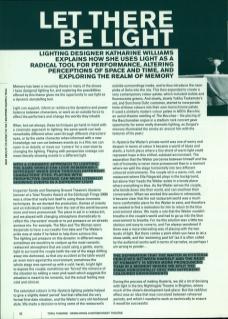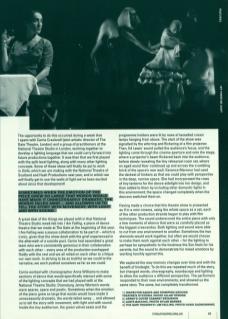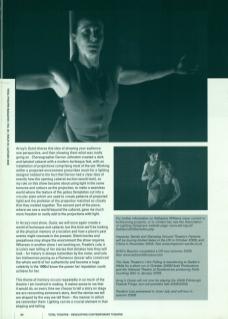Memory has been a recurring theme in many of the shows I have designed lighting for, and exploring the possibilities offered by this theme gives me the opportunity to use light as a dynamic storytelling tool.
Light can support, inform or reinforce the dynamics and power balance between characters, or work as an outside force to affect the performers and change the worlds they inhabit.
Often, but not always, these techniques go hand-in-hand with a cinematic approach to lighting: the same world can look remarkably different when seen through different characters' eyes, or by the same character when informed with a new knowledge; we can cut between events as in a film; we can zoom in on details; or move our 'camera' for a new view by changing the lighting. Playing with perspective onstage can mean literally showing events in a different light.
Inspector Sands and Stamping Ground Theatre's Hysteria (winner of a Total Theatre Award at the Edinburgh Fringe 2006) was a show that really lent itself to using these cinematic techniques. As we devised the production, themes of anxiety and an individual's isolation from the rest of the world became more and more pronounced. The piece is set in a restaurant, and we played with changing atmosphere dramatically to reflect the characters' moods or to put pressure on an already anxious trio. For example, The Man and The Woman were desperate to have a successful first date and The Waiter's pride was at stake if he failed to help them achieve this. The lighting put pressure on this dynamic in different ways: sometimes we would try to conjure up the most romantic restaurant atmosphere that we could using a gentle, warm, light to surround the couple (with the rest of the stage drifting away into darkness), so that any accident at the table would jar even more against the environment; sometimes the whole stage was opened up with a cold, harsh, bright light to expose the couple; sometimes we 'forced' the romance of the situation by adding a neon pink wash which suggests the situation is meant to be romantic, but the actual feeling was cold and clinical.
The saturated colours in the Hysteria lighting palette helped to give a slightly dated ‘period' feel that reflected the very formal first-date situation, and the Waiter's very old-fashioned style. We made a decision to bring some of the restaurant's
outside surroundings inside, and to thus introduce the neon pinks of Soho into the mix. This then expanded to create a very contemporary colour palate, which included violets and fluorescents greens. And slowly, slowly Yukiko Tsakamoto's set, and Sunchana Dulic costumes, started to incorporate hints of those colours into their own monochrome palate. (I used a similarly modern colour palate in AOD's Bacchic, an aerial theatre retelling of The Bacchae – the placing of the Bacchanalian orgies in a stadium rock concert gave opportunity for some really dramatic lighting, as Surgaz's memory illuminated the smoky air around him with the textures of his past.)
In Hysteria the Waiter's private world was one of worry and despair. In terms of colour it became a world of blues and steels, a harsh place where a tiny shard of warm light could represent hope in this chilled, subdued environment. The separation that the Waiter perceives between himself and the rest of humanity is never more pronounced than in a moment where we split the stage horizontally into two different coloured environments. The couple sit in a warm, rich, red restaurant where Ella Fitzgerald plays in the background, but above their heads the Waiter exists in a lonely place where everything is blue. As the Waiter serves the couple, s/he bends down into their world, and can overhear their conversation. When we worked this section in rehearsals, it became clear that the red restaurant world was a much more comfortable place for the Waiter to exist, and therefore we needed to find a motivation for him to return to the blue environment above. We made a rule that the Waiter couldn't breathe in the couple's world and had to go up into the blue environment to breathe. For me this solution was a little too obvious and easy to come to, and I've always wondered if there was a more interesting way of playing with the two levels of light. But there comes a point when you have to let a show settle, and the 'swimming pool bit' (as it is often called by the audience) works well in terms of narrative, so perhaps I am wrong to ponder...
During the process of making Hysteria, we did a lot of devising with light in the tiny Nightingale Theatre in Brighton, where much of the show's development took place. But this red/blue effect was an idea that was conceived between rehearsal periods, and which I needed to work on technically to ensure it would be successful.
The opportunity to do this occurred during a week that I spent with Carrie Cracknell (joint artistic director of The Gate Theatre, London) and a group of practitioners at the National Theatre Studio in London, working together to develop a lighting language that we could carry forward into future productions together. It was then that we first played with the split-level lighting, along with many other lighting concepts. Some of those ideas will finally be put to work in Dolls, which we are making with the National Theatre of Scotland and Hush Productions next year, and in which we will finally get to use the walls of light we've been excited about since that development!
A great deal of the things we played with in that National Theatre Studio week fed into I Am Falling, a piece of dance theatre that we made at The Gate at the beginning of this year. I Am Falling was a joyous collaboration to be part of which is ironic, given that the show dealt with the grief experienced in the aftermath of a suicide pact. Carrie had assembled a great team who were consistently generous in their collaboration with each other – every area of the production overlapped fluidly with the rest and we all relied on each other to critique our own work. In striving to be as truthful as we could to the narrative, we each pushed ourselves as far as we could.
Carrie worked with choreographer Anna Williams to make sections of dance that would specifically interact with some of the lighting concepts that we had played with at the National Theatre Studio. Dramaturg Jenny Worton's words were sparse, spare and poetic. Sometimes when the emotion of the piece grew so large that words would have made it unnecessarily dramatic, the words tailed away... and allowed us to tell the story with movement, with light and with sound. Inside the tiny auditorium, the green velvet seats and the programme holders were lit by rows of tasselled cream lamps hanging from above. The start of the show was signalled by the whirring and flickering of a film projector. Then, Ed Lewis' sound pulled the audience's focus, and the lighting came through the cinema aperture and onto the stage, where a projector's beam flickered back into the audience, before slowly revealing the tiny rehearsal-room set, where an aged wood floor continued up and across the crumbling brick of the space's rear wall. Garance Marneur had used the darkest of timbers so that we could play with perspective in the deep, narrow space. She had incorporated the rows of tiny lanterns for the dance sidelight into her design, and then added to them by including other domestic lights in this environment; the space changed completely when the dancers switched them on.
Having made a choice that this theatre show is presented as if in a mini-cinema, using the whole space as a set, each of the other production strands began to play with film techniques. The sound underscored the entire piece with only a few moments of silence that were as carefully placed as the biggest crescendos. Both lighting and sound were able to cut from one environment to another. Sometimes the two elements would work together, but often we would choose to make them work against each other – for the lighting to perhaps be sympathetic to the fondness the Son feels for his parents, but the sound to demonstrate his mixed emotions by working harshly against this.
We explored the way memory changes over time and with the benefit of hindsight. To do this we repeated much of the story, but changed words, choreography, soundscape and lighting to allow the audience a different perspective. The performers responded to their new environments, and showed us the same story. The same, but completely transformed.
Array's Outré shares this idea of showing your audience one perspective, and then showing them what was really going on. Choreographer Darren Johnston created a dark and twisted cabaret with a modern burlesque feel, with an installation of projections comprising most of the set. Working within a projected environment prescribes much for a lighting designer (added to the fact that Darren had a clear idea of exactly how the opening cabaret section would look), so my role on this show became about using light in the same textures and colours as the projection, to make a seamless world where the texture of the gobos (templates cut into a circular plate which are used to create patterns of projected light) and the pixilation of the projection matched so closely that they melded together. The second part of the piece, where we see a world beyond the cabaret, gave me much more freedom to really add to the projections with light.
In Array's next show, Ousia, we will once again create a world of burlesque and cabaret, but this time we'll be looking at the physical memory of a location and how a place's past events might resonate in the present. Silent movies and peepshows may shape the environment the show requires.
Whereas in another show I am working on, Trestle's Lola, it is Lola's own telling of her stories that dictates how they will look – for history is always (re)written by the victor, and Lola (an Irishwoman posing as a Flamenco dancer who convinced the whole world of her authenticity and became a huge celebrity in the 1800s) knew the power her reputation could achieve for her.
This theme of memory occurs repeatedly in so much of the theatre I am involved in making. It makes sense to me that it would do, as every time we choose to tell a story on stage we are recounting someone's story. And the stories we tell are shaped by the way we tell them – the manner in which we remember them. Lighting can be a crucial element in that shaping and telling.



